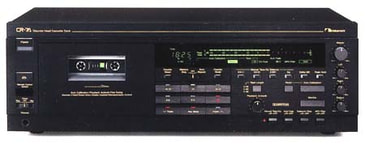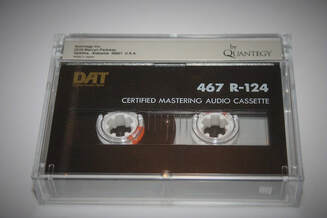Analog to Digital - Vinyl, Tape, Cassettes
Analog Studio Tape

2" 24 and 16-track, 30 or 15 ips
1/2" 2-track
1/4" mono, 2-track, 4-track
If you want a copy of old tape recordings just to hear them again, or revive abandoned musical projects from years back, that's what I do.
Even in the best conditions, tapes can come off the shelf and not play because the compound that binds the oxide to the mylar tape very slowly picks up water vapor even if it's wrapped in plastic bags and boxes.
As a matter of well-documented fact, some tapes from the 1970's and afterward were manufactured with a material that absorbs moisture from the air and becomes tacky and sticky, making the tape impossible to play and will permanently damage the recording if you try. It will squeal and shed its oxide off as it is dragged over the heads and guides of the machine.
The first thing I do is look at the tape, figure out what kind it is, what condition it is in, what it needs, and how to get it to play. If I have to bake the tape, the best thing to do is to warm the reel of tape in a convection oven that heats to about 130 degrees for some hours.
All tapes are given a catalog number, and files named and labelled. There will be one file for each track, e.g. 24-track tape results in 24 individual mono WAV file recordings of each track of the tape that will play in sync. I have Dolby SR and dbx NR decoding.
Rate for tape transfers- $50 project fee (each time you drop off tapes) plus $80 per reel. One reel, $130; five reels $450, and so on.
Recordings with excessive noises can be digitally fixed with excellent results. Crackles, pops, hiss, hum- all can be diminished. Regular $75/hr studio rates apply.
1/2" 2-track
1/4" mono, 2-track, 4-track
If you want a copy of old tape recordings just to hear them again, or revive abandoned musical projects from years back, that's what I do.
Even in the best conditions, tapes can come off the shelf and not play because the compound that binds the oxide to the mylar tape very slowly picks up water vapor even if it's wrapped in plastic bags and boxes.
As a matter of well-documented fact, some tapes from the 1970's and afterward were manufactured with a material that absorbs moisture from the air and becomes tacky and sticky, making the tape impossible to play and will permanently damage the recording if you try. It will squeal and shed its oxide off as it is dragged over the heads and guides of the machine.
The first thing I do is look at the tape, figure out what kind it is, what condition it is in, what it needs, and how to get it to play. If I have to bake the tape, the best thing to do is to warm the reel of tape in a convection oven that heats to about 130 degrees for some hours.
All tapes are given a catalog number, and files named and labelled. There will be one file for each track, e.g. 24-track tape results in 24 individual mono WAV file recordings of each track of the tape that will play in sync. I have Dolby SR and dbx NR decoding.
Rate for tape transfers- $50 project fee (each time you drop off tapes) plus $80 per reel. One reel, $130; five reels $450, and so on.
Recordings with excessive noises can be digitally fixed with excellent results. Crackles, pops, hiss, hum- all can be diminished. Regular $75/hr studio rates apply.
Vinyl

Clean your vinyl, transfer to CD or digital files.
Pops, clicks and noise are only for the sentimental- hear what's in the grooves.
Pops, clicks and noise are only for the sentimental- hear what's in the grooves.
Your LPs may be superior to the CD reissue. Assuming the vinyl master was properly done and a good pressing made, there are several advantages over remastered CDs when it comes to some legacy recordings. First-pressing LPs were cut from a brand-new master tape at the time. Some LPs never got released on CD, master tapes get lost, or the wrong tapes used for the remaster, or the mono mixes are not reissued, and so on.
Vinyl sounds better if you clean the record before playing it.
I can transfer your most beloved LPs and 45s to WAV files, or burn them onto audio CDs.
The process is this:
Clean the record of fingerprints and any especially difficult materials like food, sugar, mold, paint, or material stuck on. I start by looking for big stuck-on stuff, then apply an enzymatic cleaner that breaks down organic materials like fingerprints, dust, food, saliva, etc. which really gets a lot of the old crud out after a couple minutes. I wash the grooves with a VPI 16.5 wet record cleaner. I apply a solution, and extract it all back out with a strong vacuum, much like a carpet cleaner does. Once the record has come clean, it's ready for transfer. Even a brand-new unplayed record benefits from cleaning away the mold release compound (so it doesn't stick to the stamper) that all records have on them.
The equipment is a Pioneer linear tracking turntable, a Clearaudio Talisman cartridge, an Ayre P-5xe phono stage into a Tascam DVRA1000. All balanced interconnects by Transparent. If the records have scratches and surface noise, I can work on minimizing those, in many cases completely removing it.
Due to the nature of the work, these sessions are unattended. A typical album would cost $50, an additional $15 to clean up the scratches and noise.
Vinyl sounds better if you clean the record before playing it.
I can transfer your most beloved LPs and 45s to WAV files, or burn them onto audio CDs.
The process is this:
Clean the record of fingerprints and any especially difficult materials like food, sugar, mold, paint, or material stuck on. I start by looking for big stuck-on stuff, then apply an enzymatic cleaner that breaks down organic materials like fingerprints, dust, food, saliva, etc. which really gets a lot of the old crud out after a couple minutes. I wash the grooves with a VPI 16.5 wet record cleaner. I apply a solution, and extract it all back out with a strong vacuum, much like a carpet cleaner does. Once the record has come clean, it's ready for transfer. Even a brand-new unplayed record benefits from cleaning away the mold release compound (so it doesn't stick to the stamper) that all records have on them.
The equipment is a Pioneer linear tracking turntable, a Clearaudio Talisman cartridge, an Ayre P-5xe phono stage into a Tascam DVRA1000. All balanced interconnects by Transparent. If the records have scratches and surface noise, I can work on minimizing those, in many cases completely removing it.
Due to the nature of the work, these sessions are unattended. A typical album would cost $50, an additional $15 to clean up the scratches and noise.
Cassette Tapes

Cassette tapes transferred, I have a bank of Nakamichi decks set up. Cassettes won't need to be baked.
The typical process is to repair the cassette if necessary, or move the tape into a new shell. I align the head azimuth to the tape. Transfers to digital are made, and then there are options of computer-based spectral noise reduction, including removing unwanted tape hiss, background noise.
The typical process is to repair the cassette if necessary, or move the tape into a new shell. I align the head azimuth to the tape. Transfers to digital are made, and then there are options of computer-based spectral noise reduction, including removing unwanted tape hiss, background noise.
4-track Cassette

These recordings can sound great if you transfer them to digital. The weakest link in these machines is the electronics, and mixes made on the original machine aren't so good.
Taking the four raw tracks out into a digital session will bring out the best of the original recording. A mix made that way can sound very good, without much noise.
Taking the four raw tracks out into a digital session will bring out the best of the original recording. A mix made that way can sound very good, without much noise.
R-DAT

Those little DAT tapes. I suggest getting them transferred right away.

